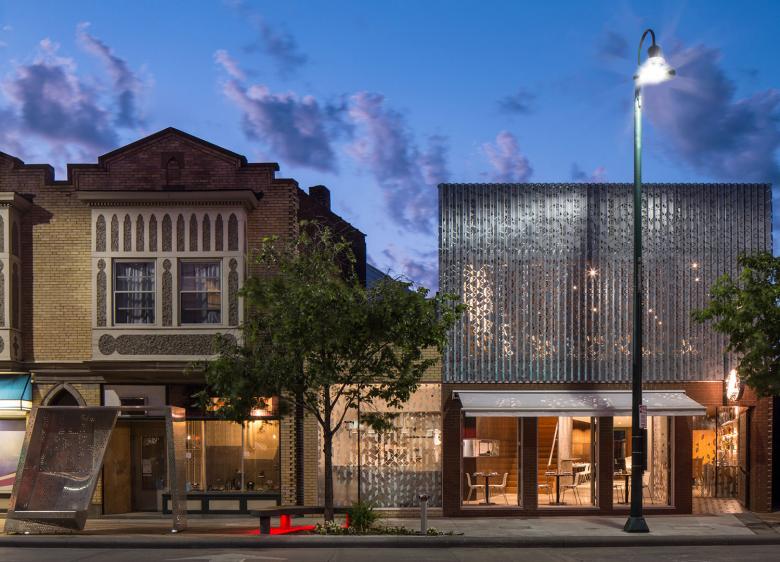Arcadian Food & Drink
In the center of Arcadian Food & Drink, a new restaurant in Cleveland's Gordon Square Arts District, is a small outdoor space, no bigger than a walk-in closet. A pane of glass facing the bar reveals the space to be a vertical garden where cooks can grab herbs and lettuces for the day's meals. This space is just one example of how Robert Maschke Architects labored over the design's details, from the aluminum rainscreen facade outside to the bamboo surfaces inside. The architects answered a few questions about the project.
What were the circumstances of receiving the commission for this project?
Cory and Rebecca Hess, purchased the last of the shuttered Gordon Square Arts District “Shot and Beer” properties, the City Grill. The existing building was condemnable and in serious need of structural repairs. Robert Maschke Architects was commissioned to design a new space to launch their first restaurant. An 18-month stabilization of the existing building from foundation to roof was undertaken, while maintaining the shell of the building.
Please provide an overview of the project.
The Arcadian Food & Drink was purchased in May 2013. At a multiplicity of levels the architecture is conceived to enhance and express a dynamic sense of movement. The lower level serves as storage and prep for the kitchen. While the small western building houses the kitchen, dish room, and service spaces. The two story eastern building envelope is devoted to the bar and dining area. Since its completion, they have developed a sustainable fine dining restaurant.
What are the main ideas and inspirations influencing the design of the building?
The Arcadian Food & Drink is situated in the Gordon Square Arts District, among nationally acclaimed theaters, galleries, and shops. The dining experience was envisioned as a theater where patrons could view the ‘show’ of the restaurant from the exterior through large windows, and become the actors on stage within the building.
How does the design respond to the unique qualities of the site?
The existing compact building was subdivided into three distinct zones, a low narrow building, a two story building, and the incision of an interior courtyard. The scale of these existing spaces lent themselves to the new program, informing the interior organization. The structural constraints of the building informed the localized articulation of the surfaces inserted into the space.
How did the project change between the initial design stage and the completion of the building?
The project was in a constant state of design evolution. Every element, detail and finish of the space was carefully considered throughout the construction process. The project continued to evolve as new constraints were discovered. With the aid of digital modeling and fabrication techniques, Robert Maschke Architects was able to work directly with the fabricators to provide a unique and comprehensive design solution.
Was the project influenced by any trends in energy-conservation, construction, or design?
The project sought to use sustainable materials in innovative ways. The Arcadian Food & Drink is a sustainable farm to table restaurant, the building construction needed to reflect those values. Bamboo clad surfaces finish the interior of the project while the exterior was constructed of using a rainscreen system to protect the building. A vertical garden was introduced in the courtyard where herbs and lettuces are grown for daily use in the menu.
What products or materials have contributed to the success of the completed building?
We worked with an elegant, yet limited palette. Dupont Corian was used to construct a durable bar and seating which folds into ceiling elements. Plyboo Bamboo was stained dark to create the interior envelope and absorb sound, a light caramel bamboo color was used to create fixed seating which folds out of the floor and stairs. White Silbonit (cementitious) panels create the exterior rainscreen, perforated by large operable openings provided by Kolbe windows and doors. A custom perforated aluminum screen adorns the South facing facade, blocking the harsh summer sun while creating a dynamic subtle diffused light in the dining space. The perforated screen was also introduced on the interior, the steel panels create a veil between the upper and lower levels.
Email interview conducted by John Hill.
Arcadian Food & Drink
2016Cleveland, Ohio
Architect
Robert Maschke Architects
Design Principal/Project Architect
Robert Maschke, FAIA
Project Manager
Matt Lindsay, Associate AIA
Project Team
Robert Maschke, FAIA; Matt Lindsay, Associate AIA; Alex Mann, Associate AIA
Structural Engineer
Barber & Hoffman; Halim Saab, P.E., LEED AP; James Colella, P.E.
Lighting/Interior Designer
Robert Maschke Architects
Contractor
Wiatroski Construction
Constuction Manager
Robert Maschke Architects
Solid Surfaces
DuPont Corian
Bamboo Surfaces
Plyboo
Doors and Windows
Kolbe Doors and Windows
Exterior Cladding
Silbonit
Chairs and Stools
Vitra
Building Area
4,261 sf
Photographs
Brad Feinknopf
Drawings
Robert Maschke Architects















